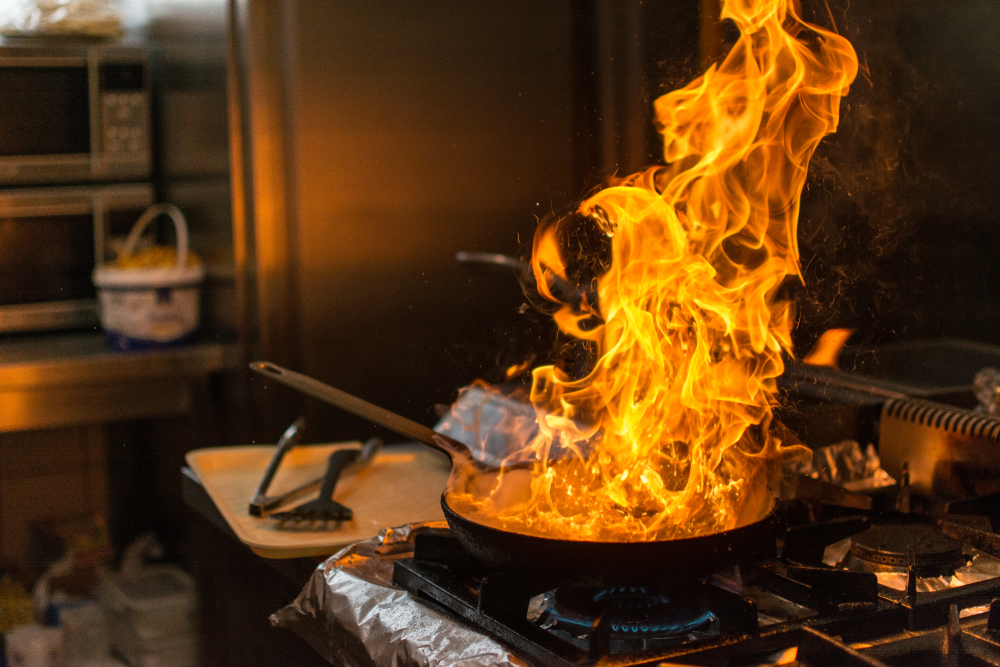Seattle Kitchen Fire Suppression System Inspection

Your commercial kitchen is constantly exposed to fire risks due to its large-scale industrial equipment. A fire can spark from either a malfunction in your gas supply or from grease and oil buildup combined with large amounts of heat and smoke. To keep these grease fires from breaking out, commercial kitchens have a fire suppression system in their stove or fryers. This fire protection system alerts building occupants in the event of a fire and quickly extinguishes the flames.
As a building or restaurant owner, having a fire suppression system is essential, but you must ensure it is in good working condition and placed in the correct location. That’s where Pacific Fire & Security comes in. As your local Seattle-certified fire protection agency, we offer fire suppression system inspection and certification services to keep your kitchen safe and compliant.
What is a Kitchen Fire Suppression System?
A kitchen fire suppression system is a safe, effective, and convenient fire protection equipment that extinguishes a fire directly at the source. It is located where most kitchen fires break out— stoves or fryers.
A kitchen fire suppression system works by first detecting smoke or heat. The system’s nozzles then discharge wet chemicals from above the appliance. The wet chemicals cover the flames and starve the fire. Once activated, the system disconnects the gas line from your appliances. The hood automatically turns on to remove the smoke caused by the fire. The kitchen remains unaffected, with minimal damage to the cooking area.

Kitchen Fire Suppression System Inspection in Seattle
In the case of a spark or fire, a properly working kitchen hood suppression system will:
- Cut off your stove’s gas supply.
- Discharge a chemical solution that exterminates grease fires, converting the flames into a nonflammable soap substance.
- Turn on your fan system to remove accumulated smoke.
During your kitchen hood inspection, our certified fire technicians will:
- Check for system damages
- Inspect all electrical parts, piping, nozzles, ducts, and control components
- Examine tank conditions
- Ensure the hood is clean and dry
- Check the hood globes for water or moisture damage
- Clean the system
Kitchen Fire Suppression System FAQ
What is a kitchen fire suppression system?
A kitchen fire suppression system is usually installed over your stove tops and within the hood of your kitchen stove. This suppression system is an automatic fire control system that puts out kitchen grease fires. When it detects heat or smoke, it releases wet chemicals to put out the flames, and the hoot automatically turns on to eliminate any smoke. It will also cut the energy of your appliances to aid in putting out the fire.
How does a fire suppression system work?
A fire suppression system detects heat or smoke. It has a built-in alarm system to alert the building owner of an emergency while simultaneously using a chemical substance to extinguish the fire.
How often should a kitchen hood fire suppression system be inspected?
It is required that a licensed fire safety company inspect your kitchen hood, at a minimum, every six months.
Am I required to have a fire-suppression kitchen hood?
Yes, to comply with NFPA fire code 96, you must have a fire suppression system in your commercial kitchen. This code is in place to prevent the outbreak of hazardous grease fires in your commercial building.
What are the benefits of a kitchen hood fire suppression system?
The most significant benefit of a kitchen suppression system is the protection it provides for your employees and customers. Also, because it automatically eliminates fires, it can stop a fire without anyone being physically present, such as on nights or off-hours. Overall it is imperative to have a suppression system as it minimizes your fire risk, reduces potential costs of damages, provides you with a sense of safety, and ensures your kitchen meets fire code requirements.
What is NFPA 96?
NFPA 96 is a fire code outlining the fire safety requirements and regulations for public and private commercial cooking spaces.


